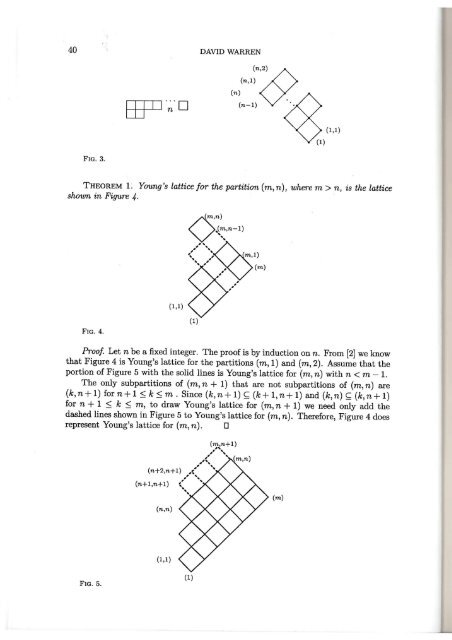You also want an ePaper? Increase the reach of your titles
YUMPU automatically turns print PDFs into web optimized ePapers that Google loves.
40<br />
DAVID WARREN<br />
YOUNG'S LATTICES 41<br />
EEf=D ·~·<br />
D<br />
(n)<br />
(n,1)<br />
(n,2)<br />
The following theorem is another extension of a theorem found in [2].<br />
THEOREM 2. Young's lattice for the partition (m, 1, 1, ... , 1) with n rows is as<br />
shown in the lattice in Figure 6.<br />
(1 ,1)<br />
(1)<br />
FIG. 3.<br />
(1, ... ,1) (m)<br />
THEOREM 1. Young 's lattice for the partition (m, n), where m > n, is the lattice<br />
shown in Figure 4.<br />
FIG. 4.<br />
(1,1) 8>/<br />
~n)<br />
vs{~·n-1)<br />
, ..<br />
': ~ (m,1)<br />
.. ,<br />
.... ,' , (m)<br />
(1)<br />
Proof Let n be a fixed integer. The proof is by induction on n. From [2] we know<br />
that Figure 4 is Young's lattice for the partitions (m, 1) and (m, 2). Assume that the<br />
portion of Figure 5 with the solid lines is Young's lattice for (m, n) with n < m- 1.<br />
The only subpartitions of ( m, n + 1) that are not subpartitions of ( m, n) are<br />
(k,n+ 1) for n+ 1::; k::; m. Since (k,n+ 1) ~ (k+ 1,n+ 1) and (k,n) ~ (k,n+ 1)<br />
for n + 1 ::; k ::; m, to draw Young's lattice for (m, n + 1) we need only add the<br />
dashed lines shown in Figure 5 to Young's lattice for (m, n). Therefore, Figure 4 does<br />
represent Young's lattice for (m, n). 0<br />
(~,n+1)<br />
, ..<br />
" (m,n)<br />
, ..<br />
,,'t'<br />
..<br />
(n+2,n+1) ,,,(: .. ,<br />
(n+l,n+l) (. 1 '<br />
....,<br />
(n,n)<br />
(m)<br />
FIG. 6.<br />
(1)<br />
Once we found the general forms of partitions with two-dimensional Young's<br />
lattices, we began looking at the conjugates of these partitions and their representative<br />
lattices. The conjugate partition of a given partition is the partition obtained by<br />
switching the rows and columns of Ferrer's diagram for the given partition. To switch<br />
between a lattice and its conjugate we developed different numbering grids. The two<br />
dimensional lattices are obtained from three general types of partitions. The first is<br />
a partition with exactly one row or its conjugate with exactly one column in Ferrer's<br />
diagram. Since Young's lattices of these partitions are single chains, they can be<br />
drawn on any of the following grids.<br />
The second type of partition is one with exactly two rows and any number of<br />
columns or its conjugate with exactly two columns and any number of rows. In this<br />
case, we need two different labelings (grids) when converting between a lattice and<br />
its conjugate.<br />
First, consider the partition with exactly two rows. We will label the spine of<br />
the lattice as the line connecting the subpartitions of the form ( n, n - 1). The origin<br />
of the lattice is the position of the subpartition (1). Labeling from the origin, each<br />
time we move one position up and to the right, we add one to the first row of the<br />
subpartition. Each time we move one position up and to the left, we add one to the<br />
second row of the subpartition (as long as in the partition ( x, y), x 2: y) as shown in<br />
Figure 7.<br />
(5)<br />
FIG. 7.<br />
FIG. 5.<br />
(1,1)<br />
(1)<br />
<strong>No</strong>w we will consider the conjugate, the partition with exactly two columns. The<br />
spine of this lattice is the line connecting the subpartitions of the form (2, 2, ... , 2, 1)<br />
with n rows. The origin of this lattice is also the position of the subpartition (1).<br />
Labeling from the origin, each time we move one position up and to the left we add
















